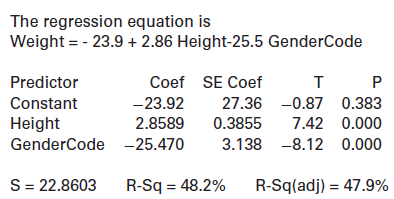Categorical variables with only two categories (such as male/female or yes/no) can be used in a multiple
Question:

(a) What weight does the model predict for a male who is 5€™7€ (67 inches)? For a female who is 5€™7€?
(b) Which predictors are significant at a 5% level?
(c) Interpret the coefficient of Height in context.
(d) Interpret the coefficient of GenderCode in context. (Pay attention to how the variable is coded.)
(e) What is R2 for this model? Interpret it in context.
Fantastic news! We've Found the answer you've been seeking!
Step by Step Answer:
Related Book For 

Statistics Unlocking The Power Of Data
ISBN: 9780470601877
1st Edition
Authors: Robin H. Lock, Patti Frazer Lock, Kari Lock Morgan, Eric F. Lock, Dennis F. Lock
Question Posted:





